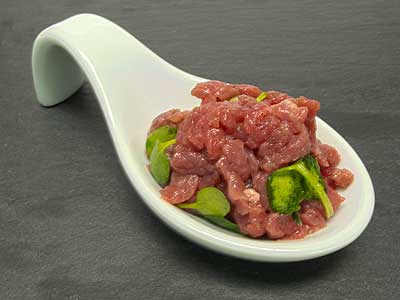September 5, 2011
Amuse-Bouche

tartare d’agneau
(lamb tartar)
I’ve always liked the flavor of raw meat, and when given a chance to taste some muscle I haven’t had before, I will. When I butcher, I’ll sample bits of meat from different parts of an animal to see how different muscles really do taste differently. At times, the opportunity to taste has come in other ways than standing at a butcher block. In 1989, I had an all chicken meal in Kyoto that included chicken sashimi. I loved it. Earlier this year, I was at the Fancy Food Show in San Francisco where I sampled a number of different raw muscles from Ibérico pigs raised on acorns. The mock tender was really outstanding.
Maybe the best piece of raw meat that I’ve ever eaten comes from a small muscle in the leg of the lamb. When butchering lamb, I do the entire process with hand tools and pretty much bone out the entire animal. This leaves me with many non-standard but tasty cuts. One of my favorite is the inside round from the rear leg. The upper rear leg can be broken into four major muscles. The inside round is the large muscle on the medial side of the leg. (This may be the m. semimembranosus, but I’m not sure.) The muscle has a somewhat triangular shape, and upon close inspection and with a little knife work, can be further divided along some minor seams into three pieces. There’s a thin cap muscle that can be shredded and stir-fried. The largest piece becomes more rectangular in shape after being separated from the others, and is great seasoned with only salt and pepper and cooked to 57 °C (135 °F). I can’t begin to describe the thrill I felt the first time I tasted the third little piece of muscle from the inside round. If I was a cartoon character, fireworks would have been lighting up the sky behind me.
This little triangular piece of meat weighs in at 100 to 130 g (3-1⁄2 to 4-1⁄2 oz), and has a velvety, slightly chewy texture. The flavor is sweet and meaty. The color is slightly purplish, but still quite red. When I serve it to guests without first telling them what it is, lamb is never one of their first or second guesses.
The difficulty with this amuse-bouche is obtaining the main ingredient. Each time I butcher a lamb, I pick up just two of these muscles, each of which will produce about 6 to 8 amuse-bouche servings, from a whole carcass. The muscle freezes well if vacuum packed. I haven’t tried, but I assume if I was to purchase a normal leg of lamb from a grocery store, I could harvest this morsel from one of these cryovaced puppies.
Preparation is quite simple. First, the meat has to hand cut into a very small dice. I aim for cubes of 3 mm (1⁄8 in) per side or less. Do not grind the meat. Besides loosing some of the precious meat to grinder yield, the grinder will crush and mush the meat. By slicing the meat into small cubes, no juice will be lost and the texture will remain intact. Also, I never cut the meat more than a hour in advance of service to maximize its moisture retention.
Just prior to service, the meat is folded together with a few drops of Kadoya-brand roasted sesame seed oil and Okinawan shekwasha juice. You should only barely be able to smell the oil and barely sense the juice. Finally, a few micro-green leaves are added for color. In the picture, the snipped leaves from daikon sprouts were used. The finished tartar should be served in spoons so no other utensils are needed to enjoy it.
© 2011 Peter Hertzmann. All rights reserved.
